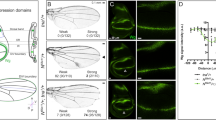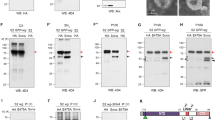Abstract
THE function of the frizzled (fz) locus in Drosophilia melanogaster is required to coordinate the cytoskeletons of epidermal cells to produce a parallel array of cuticular hairs and bristles (for example on the wild-type wing all hairs point towards the distal tip)1,2. In fz mutants it is not the structure of individual hairs and bristles that is altered, but their orientation with respect to their neighbours and the organism as a whole. Mitotic clone analysis3 indicates that fz has two functions in the developing wing. It is required for the proximal-distal transmission of an intercellular polarity signal, a process that is expected to be at least partly extracellular. It is also required for cells to respond to the polarity signal, which is expected to be a cytoplasmic function. The fz locus could encode either one bifunctional or two single-function proteins. We report here that, in pupae, fz produces a messenger RNA that encodes a protein with seven putative transmembrane domains. Thus, the Fz protein should contain both extracellular and cytoplasmic domains, which could function in the transmission and interpreta-tion of polarity information, respectively. This is the first reported sequence for the protein product of a tissue polarity gene.
This is a preview of subscription content, access via your institution
Access options
Subscribe to this journal
Receive 51 print issues and online access
$199.00 per year
only $3.90 per issue
Buy this article
- Purchase on Springer Link
- Instant access to full article PDF
Prices may be subject to local taxes which are calculated during checkout
Similar content being viewed by others
References
Gubb, D. & Garcia-Bellido, A. J. Embryol. exp. Morph. 68, 37–57 (1982).
Adler, P. N., Charlton, J. & Vinson, C. Devl Genet. 8, 99–119 (1987).
Vinson, C. R. & Adler, P. N. Nature 329, 549–551 (1987).
Bingham, P. M., Levis, R. & Rubin, G. M. Cell 25, 693–704 (1981).
Searles, L. L., Jokerst, R. S., Bingham, P. M., Voelker, R. A. & Greenleaf, A. L. Cell 31, 585–592 (1982).
Vinson, C. R. thesis Univ. Virginia (1987).
Kyte, J. & Doolittle, R. F. J. molec. Biol. 157, 105–132 (1982).
Engelman, D. M., Steitz, T. A. & Goldman, A. A. Rev. biophys. Chem. 15, 321–353 (1986).
von Heijne, G. J. molec. Biol. 184, 99 (1985).
Brandl, C. J. & Deber, C. M. Proc. natn. Acad. Sci. U.S.A. 83, 917–921 (1986).
Dohlman, H. G., Caron, M. G. & Lefkowitz, R. J. Biochemistry 26, 2657–2663 (1987).
Pearson, W. R. & Lipman, D. J. Proc. natn. Acad. Sci. U.S.A. 85, 2444–2448 (1988).
Lawrence, P. A. J. exp. Biol. 49, 607–620 (1966).
Nardi, J. B. & Kafatos, F. V. J. Embryol. exp. Morph. 136, 489–512 (1976).
Tucker, J. B. J. Embryol. exp. Morph. 65, 1–18 (1981).
Gilman, A. G. A. Rev. Biochem. 56, 615–649 (1987).
Kobilka, B. K. et al. Science 240, 1310–1316 (1988).
Poole, S. J., Kauvar, B. D. & Kornberg, T. Cell 40, 37–43 (1985).
Cavener, D. R. Nucleic. Acids Res. 15, 1353–1361 (1987).
Author information
Authors and Affiliations
Rights and permissions
About this article
Cite this article
Vinson, C., Conover, S. & Adler, P. A Drosophila tissue polarity locus encodes a protein containing seven potential transmembrane domains. Nature 338, 263–264 (1989). https://doi.org/10.1038/338263a0
Received:
Accepted:
Issue Date:
DOI: https://doi.org/10.1038/338263a0
This article is cited by
-
Cancer chemoprevention through Frizzled receptors and EMT
Discover Oncology (2021)
-
Wnt signaling in breast cancer: biological mechanisms, challenges and opportunities
Molecular Cancer (2020)
-
The role of GPCRs in bone diseases and dysfunctions
Bone Research (2019)
-
Antagonistic PCP Signaling Pathways in the developing Drosophila eye
Scientific Reports (2018)
-
MiR-23a/-24-induced gene silencing results in mesothelial cell integration of pancreatic cancer
British Journal of Cancer (2015)
Comments
By submitting a comment you agree to abide by our Terms and Community Guidelines. If you find something abusive or that does not comply with our terms or guidelines please flag it as inappropriate.



